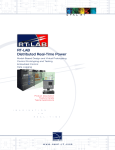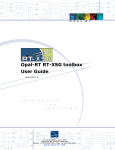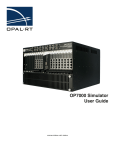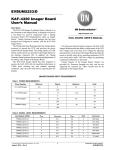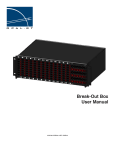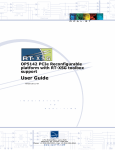Download User Manual - Opal-RT
Transcript
OP5000 Signal Conditioning & I/O Products for RT-LAB Engineering Simulators OP5340 Analog to Digital Converter Module User Manual Published by Opal-RT Technologies, Inc. 1751 Richardson, suite 2525 Montréal (Québec) Canada H3K 1G6 www.opal-rt.com © 2005 Opal-RT Technologies, Inc. All rights reserved Printed in Canada OP5340_user_manual.doc Rev.A User Manual OP5340 1 INTRODUCTION The OP5340 module provides 16 differential analog input channels. Each of them uses 16-bit resolution Analog-to-Digital Converter. After it has been assembled, each channel is calibrated separately for better accuracy. The OP5340 module has also signal conditioning capabilities, which permit the user to apply up to 240 volts signal on the inputs. By default, the maximum input signal is set to 40 volts. Figure 1: OP5340 Differential Input Analog to Digital Converter Module 2 DESCRIPTION The OP5340 module is one of a range of function modules for the OP5000 FPGA I/O system from Opal-RT Technologies. It allows up to 16 analog signals to be sampled simultaneously through a single module. Given that both the OP5130 External FPGA Processor, and the passive OP5220 carrier can accommodate up to two mezzanine modules; it allows up to 32 signals to be captured per carrier. Several carriers can be connected to a single board slot on an RT-LAB simulator via the OP5110 or OP5120 I/O interface. The OP5340 module features 16 differential channels with individual 16-bit Analog-to-Digital Converters (ADC), which ensures simultaneous signal capture from multiple channels, thus eliminating the skew errors associated with multiplexed channels. Each ADC can sample up to 500 User Manual OP5340 kS/s, giving a total throughput of 8 MS/s. On board signal conditioning provides offsets and gains from +/- 100 mV to +/- 16 V as well as over-voltage protection. 2.1 OFFSET CALIBRATION OP5340 module contains a serial EEPROM to store the module identification, calibration information and any other important information. Each OP5340 module is calibrated after assembly. During the calibration, gain and offset are adjusted to meet the OP5340 module specification. The information stored in the EEPROM can be acceded via an interface when module is connected to the OP5130 or OP5220 carrier. RT-LAB, Opal-RT’s simulation software, during the LOAD, reads the EEPROM contents of each OP5340 (ADC) and OP5330 (DAC) module connected to the OP5110 FPGA PCI board. For each module, the calibration parameters stored in the EEPROM are used to determine the gain and offset values of each channel. At run time ADC values are read from the modules and DAC values to be written to the modules are corrected using these gain and offset values. 2.2 CIRCUIT DIAGRAM Figure 2 represents a simplified schematic of one channel of the OP5340 module. It is composed of three stages. First stage consists of one operational amplifier that works in differential input mode and permits the gain adjustment. Second stage, the level shifter, forms the signal for the A/D converter input. Then, after the conversion to the digital type, the signal is sent to the OP5110 FPGA PCI board or OP5130 FPGA carrier. Differential Amplifier V in Level Shifter A / D Converter + + - VIN V ref. - V ref. REF Figure 2: OP5340 Differential Input ADC Module circuit OUT Serial Data Out User Manual OP5340 2.3 ANALOG INPUT SPECIFICATIONS 2.3.1 TECHNICAL SPECIFICATIONS Number of channels: 16 differentials Resolution: 16 bits Max. Sampling Frequency: 500 kS/s Min Conversion / Acquisition Time: 2 µs per channel Type of ADC: 2.3.2 8 x Dual ADC with 10 MBit/s Serial Output Transfer NOMINAL INPUT RANGES (V) Positive Full Scale Negative Full Scale +120.0 -120.0 +100.0 -100.0 +80.0 -80.0 +60.0 -60.0 +40.0 -40.0 +20.0 -20.0 Hardware default value 2.3.3 2.3.4 DC TRANSFER CHARACTERISTICS No missing codes resolution: 14 bits min. Integral nonlinearity (INL): ±8 LSB max. Differential nonlinearity (DNL): ±1.5 LSB typ. (0 to +70°C) CMRR: 90 dB DYNAMIC CHARACTERISTICS Bandwidth: Small signal (-3 dB): 820 kHz Large signal (1% THD): 55 kHz System noise: 1.8 LSB rms (including quantization) User Manual OP5340 2.3.5 CALIBRATION Programmable gain and offset calibration for each A/D. Calibration factors are stored in on-board non-volatile memory (flash memory). 2.3.6 Recommended warm-up time: 5 min. Calibration interval: as required PHYSICAL DIMENSIONS 6.73 cm x 12.70 cm (2.65" x 5.00") I/O connector: 80-pin hi-speed header to carrier 2.3.7 2.3.8 ENVIRONMENTAL Operating temperature: 0 to 70 °C Storage temperature: -55 to 85 °C Relative humidity: 10 to 90%, no condensing Maximum altitude: 2,000 m PIN ASSIGNMENTS See Appendix A. User Manual OP5340 2.4 MODULE INSTALLATION The OP5340 ADC module can only be used with Opal-RT’s carrier boards type B. The position on the carrier board is determined by the firmware version of the driving FPGA board. On the same carrier two modules can be used simultaneously. The figure 3 shows OP5340 module installed in the section B of the OP5130 active carrier. Two polarized connectors fasten the module in the suitable position and four screws retain it for the better connection with the carrier. Figure 3: OP5340 Differential Input ADC Module position User Manual OP5340 2.5 BOARD SETTINGS 2.5.1 INPUT GAIN SELECTION The OP5340 ADC module has user selectable input gain ability. By default, the maximum input voltage is set to 40 volts but each channel can be changed separately up to 240 volts. The OP5340 ADC module contains sockets, which permit to insert additional precision resistors and change the input gain. The image on the right shows the placement for the additional resistors. Please, refer to the table at the Ch00 resistors position end of this section for the exact relationship between channels and resistors. The next diagram illustrates input stage of one channel. The default values for the resistors R1 and R2 were chosen to keep the maximum input voltage range of ±20 volts (40 volts) with no additional resistors. Vout full range = ±1 volt (2 volts) R1 R2 Installed resistors: V OUT V IN R1 = 499 kohms R2 = 25 kohms R1 R2 ⎛ R2 ⎞ Vout = ⎜ ⎟Vin ⎝ R1 ⎠ The surface mount resistors already installed on the OP5340 module give an attenuation of 20. Vin 1 / 20 Vout User Manual OP5340 Input Gain Calculations Next figure shows the complete circuit with resistor Rx as the axial insertable resistor by the user. Rx R1 R2 V IN V OUT + R1 R2 Rx ⎛ R 2 ⎞⎛ Rx ⎞ Vout = ⎜ ⎟⎜ ⎟Vin ⎝ R1 ⎠⎝ R 2 + Rx ⎠ with already installed on board resistors R1=499k and R2=25k Vout = 1 ⎛ Rx ⎞ ⎜ ⎟Vin 20 ⎝ 25 + Rx ⎠ User may define his own input Gain Value and calculate the corresponding Rx resistor value. Following table gives popular value of maximum ranges and associated Rx resistor values (chosen in 1% series range). To get the same unit of measurement, the model has to compensate for any new gain value different from the original gain of 1/20. Last column gives the Gain to insert in the input signal of the simulation model. Input Gain Max Voltage Input Rx value 1% series range Gain to insert in the model 1/20 ±20V (or 40V) none 1 1/40 ±40V (or 80V) 24.9 kohms 2 1/60 ±60V (or 120V) 12.4 kohms 3 1/80 ±80V (or 160V) 8.25 kohms 4 1/100 ±100V (or 200V) 6.20 kohms 5 User Manual OP5340 1/120 ±120V (or 240V) 4.99 kohms 6 Example: Added Rx resistor of 4.99 kohms in parallel with R2 resistor gives an attenuation of 120 so the input voltage can be increase up to ±120 volts (or 240 volts). Vin 1 / 120 Vout Table 5 shows the relationship between channel and resistor references used for the input gain changes. Channel # Resistor Rx Channel 00 R164, R165 Channel 01 R180, R181 Channel 02 R166, R167 Channel 03 R182, R183 Channel 04 R168, R169 Channel 05 R184, R185 Channel 06 R170, R171 Channel 07 R186, R187 Channel 08 R172, R173 Channel 09 R188, R189 Channel 10 R174, R175 Channel 11 R190, R191 Channel 12 R176, R177 Channel 13 R192, R194 Channel 14 R178, R179 Channel 15 R193, R195 Table 5: Relation between channels and resistors User Manual OP5340 2.5.2 PIN ASSIGNMENTS Only external screw terminal board or custom cable that are connected to the carrier board has access to all input channels of the OP5340 module. Table 6 gives the pin assignments when using OP5941 (76-pos) Screw Terminal board. Pos # Description Pos # Description 1 IN 00 + 17 IN 08 + 2 IN 00 - 18 IN 08 - 3 IN 01 + 19 IN 09 + 4 IN 01 - 20 IN 09 - 5 IN 02 + 21 IN 10 + 6 IN 02 - 22 IN 10 - 7 IN 03 + 23 IN 11 + 8 IN 03 - 24 IN 11 - 9 IN 04 + 25 IN 12 + 10 IN 04 - 26 IN 12 - 11 IN 05 + 27 IN 13 + 12 IN 05 - 28 IN 13 - 13 IN 06 + 29 IN 14 + 14 IN 06 - 30 IN 14 - 15 IN 07 + 31 IN 15 + 16 IN 07 - 32 IN 15 - Table 6: Differential amplifier pin assignment for analog input User Manual OP5340 3 APPENDIX A - PIN ASSIGNMENTS Use these pin assignments only if you are not using the carrier board type B (OP5220) or the standard screw terminal (OP5941) 3.1 I/O CONNECTORS (J1) 1 3 5 7 9 11 13 15 17 19 21 23 25 27 29 31 33 35 37 39 G1 G3 G5 G7 41 43 45 47 49 51 53 55 57 59 61 63 65 67 69 71 73 75 77 79 SEL_+V SEL_+V +12V NC EXT_A/B_1 EXT_A/B_2 NC NC EXT_A/B_5 EXT_A/B_6 NC NC EXT_A/B_9 EXT_A/B_10 NC NC EXT_A/B_13 EXT_A/B_14 NC NC AGND AGND AGND AGND EXT_A/B_17 EXT_A/B_18 NC NC EXT_A/B_21 EXT_A/B_22 NC NC EXT_A/B_25 EXT_A/B_26 NC NC EXT_A/B_29 EXT_A/B_30 NC NC NC +12V SEL_+V SEL_+V SEL_-V SEL_-V -12V NC NC NC EXT_A/B_3 EXT_A/B_4 NC NC EXT_A/B_7 EXT_A/B_8 NC NC EXT_A/B_11 EXT_A/B_12 NC NC EXT_A/B_15 EXT_A/B_16 AGND AGND AGND AGND NC NC EXT_A/B_19 EXT_A/B_20 NC NC EXT_A/B_23 EXT_A/B_24 NC NC EXT_A/B_27 EXT_A/B_28 NC NC EXT_A/B_31 EXT_A/B_32 NC -12V SEL_-V SEL_-V Table 1 I/O Connectors Pinout 2 4 6 8 10 12 14 16 18 20 22 24 26 28 30 32 34 36 38 40 G2 G4 G6 G8 42 44 46 48 50 52 54 56 58 60 62 64 66 68 70 72 74 76 78 80 User Manual OP5340 3.2 CONTROL CONNECTORS (J2) 1 3 5 7 9 11 13 15 17 19 21 23 25 27 29 31 33 35 37 39 G1 G3 G5 G7 41 43 45 47 49 51 53 55 57 59 61 63 65 67 69 71 73 75 77 79 +5V MCTRL_A/B_1 MCTRL_A/B_2 MCTRL_A/B_3 MCTRL_A/B_4 MCTRL_A/B_5 +5V MCTRL_A/B_6 MCTRL_A/B_7 MCTRL_A/B_9 MCTRL_A/B_11 MCTRL_A/B_13 +5V MCTRL_A/B_15 MCTRL_A/B_17 MCTRL_A/B_19 MCTRL_A/B_20 MCTRL_A/B_21 MCTRL_A/B_23 +5V GND GND GND GND +5V MCTRL_A/B_25 MCTRL_A/B_27 MCTRL_A/B_29 MCTRL_A/B_30 MCTRL_A/B_31 MCTRL_A/B_33 +5V MCTRL_A/B_35 MCTRL_A/B_37 MCTRL_A/B_39 MCTRL_A/B_40 MCTRL_A/B_42 +5V MCTRL_A/B_44 MCTRL_A/B_46 MCTRL_A/B_48 MCTRL_A/B_49 MCTRL_A/B_51 +5V +5V EEPROM_SCL EEPROM_SDA EEPROM_WP EEPROM_A2 EEPROM_A1 +5V EEPROM_A0 MCTRL_A/B_8 MCTRL_A/B_10 MCTRL_A/B_12 MCTRL_A/B_14 +5V MCTRL_A/B_16 MCTRL_A/B_18 CARD_ID_5 CARD_ID_4 MCTRL_A/B_22 MCTRL_A/B_24 +5V GND GND GND GND +5V MCTRL_A/B_26 MCTRL_A/B_28 CARD_ID_3 CARD_ID_2 MCTRL_A/B_32 MCTRL_A/B_34 +5V MCTRL_A/B_36 MCTRL_A/B_38 CARD_ID_1 MCTRL_A/B_41 MCTRL_A/B_43 +5V MCTRL_A/B_45 MCTRL_A/B_47 CARD_ID_0 MCTRL_A/B_50 MCTRL_A/B_52 +5V Table 2 Control Connectors Pinout 2 4 6 8 10 12 14 16 18 20 22 24 26 28 30 32 34 36 38 40 G2 G4 G6 G8 42 44 46 48 50 52 54 56 58 60 62 64 66 68 70 72 74 76 78 80 User Manual OP5340 4 APPENDIX B - RELATED SIGNAL CONDITIONING PRODUCTS 4.1 TERMINATION PANELS: Model OP5941 is a dual 38-screw terminal made to connect field I/O signals to the OP53xx module family.















